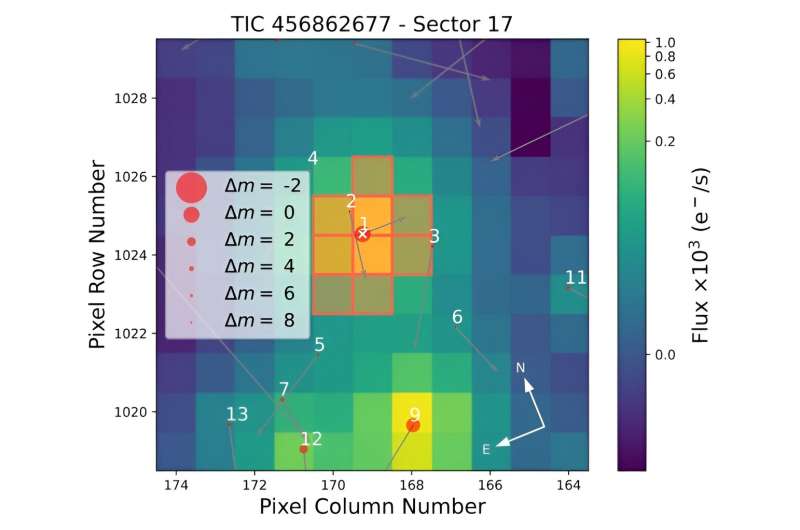December 5, 2023 report
This article has been reviewed according to Science X's editorial process and policies. Editors have highlighted the following attributes while ensuring the content's credibility:
fact-checked
preprint
trusted source
proofread
New warm Jupiter exoplanet discovered

An international team of astronomers has discovered a new warm Jupiter exoplanet orbiting a distant G-type star. The newfound alien world, designated TOI-4515 b, is similar in size to Jupiter but about two times more massive than it. The finding was detailed in a paper published Nov. 20 on the pre-print server arXiv.
TESS is currently performing a survey of approximately 200,000 of the brightest nearby stars with the main goal of searching for transiting exoplanets. So far, it has identified nearly 7,000 candidate exoplanets (TESS Objects of Interest, or TOI), of which 402 have been confirmed.
Warm Jupiters are gas giant planets with orbital periods between 10 and 200 days. This makes them challenging targets for transit detection and radial velocity (RV) follow-up studies compared to their shorter-orbit counterparts, dubbed hot Jupiters.
Now, a group of astronomers led by Ilaria Carleo of the University of La Laguna, Spain, reports the discovery of a new warm Jupiter—with an orbital period of approximately 15.26 days. Using TESS, they identified a transit signal in the light curve of TOI-4515—a G-star slightly smaller and less massive than the sun, located some 632 light years away.
The planetary nature of this signal was confirmed by follow-up radial velocity measurements with the HARPS-N spectrograph on the Galileo National Telescope located on the island of La Palma in the Canary Islands, Spain.
The newly detected exoplanet TOI-4515 b has a radius of 1.09 Jupiter radii and its mass is approximately 2.01 Jupiter masses, which yields a density of about 1.95 g/cm3. It takes this planet 15 days and six hours to encircle its host on an eccentric orbit (with an eccentricity of 0.46), at a distance of nearly 0.12 AU from it. The equilibrium temperature of TOI-4515 b is estimated to be 705 K.
When it comes to the parent star TOI-4515, it has a spectral type G8/G9 and is about 1.2 billion years old. The star has a radius of 0.875 solar radii and its mass is 0.92 solar masses. The effective temperature of TOI-4515 is estimated to be about 5,400 K, while its metallicity was found to be at a level of 10 percent above the solar metallicity.
Trying to explain the high eccentricity of TOI-4515 b's orbit and the planet's relatively high density, the astronomers suppose that it may be a result of a violent dynamical past characterized by planetary collisions.
"It is a possibility that multiple gas giants formed within the system. After the gaseous disk dissipated, these gas giants may have experienced interactions, such as planet–planet scattering or secular interactions, that led to the excitation of TOI-4515 b's eccentric orbit," the researchers explained.
The authors of the paper concluded that further observations of the TOI-4515 system, such as imaging with the adaptive optics instruments are needed in order to confirm this hypothesis.
More information: Carleo et al, The GAPS Programme at TNG L—TOI-4515 b: An eccentric warm Jupiter orbiting a 1.2 Gyr-old G-star, arXiv (2023). DOI: 10.48550/arxiv.2311.11903
Journal information: arXiv
© 2023 Science X Network



















